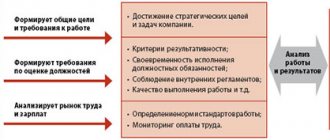The essence of the system
The employee's salary is established by the employment contract in accordance with the current remuneration system in this organization in accordance with labor legislation. The most common are piecework, time-based and tariff systems. At the same time, the employer tries to find a salary calculation option that most accurately meets the specifics of its activities and allows for a better assessment of the contribution of each employee in achieving common goals. One such method is the grading system.
So what is a position grade in the remuneration system? The term comes from the English word grade - class, category, degree. Grading (from the English grading) - classification, sorting, ordering. Grading is the ranking of positions, their hierarchical positioning in accordance with the value of the position for the enterprise. This gives the position an advantage not just in terms of vertical subordination or complexity of work, but also depending on its importance for the goals of the organization.
Despite the fact that, according to Art. 22 of the Labor Code of the Russian Federation, the employer is obliged to provide employees with equal pay for work of equal value; Article 132 of the Labor Code of the Russian Federation states that the salary of each employee depends on his qualifications, the complexity of the work performed, the quantity and quality of labor expended. This allows you to use salary grades based on the employee’s business qualities, both personal and professional qualifications.
Unlike the tariff system, with the grading system the size of the salary is influenced not only by education, experience and skills, but also by other criteria important for the organization and position: controllability standards, the volume of communications, the level of responsibility and independence, the cost of an error, and others. Moreover, the factors are universal for assessing all positions; all company personnel are assessed according to one set of criteria.
What it is?
Personnel grading is the process of evaluating positions in a company according to certain criteria.
Examples of such assessment factors include the following:
- presence of managerial functions, number of subordinates;
- the degree of participation in the company's profits;
- independence in decision making;
- experience;
- the cost of such an employee's mistake.
This is just an approximate list that is approved at each enterprise that has adopted such a system.
The grades are similar to the categories in the tariff system. Positions are arranged in a hierarchical chain. It is formed based on the employee’s value to the business. Each grade receives a salary range and its own social package.
Thanks to grading, it is possible to eliminate a number of problems, including linking the size of a worker’s salary with his contribution to the development of the enterprise.
When to use
The grading system is suitable for large and medium-sized enterprises. The costs of introducing the method and large-scale preparatory work are high, and in companies with a small staff they are not justified. In addition, the main advantage of the grade system is that in companies with a large number of employees, it allows you to clearly optimize the structure, get rid of such hierarchical positions as “senior”, “junior” and the like, i.e. it will allow you not to inflate the staff. And it gives employees the opportunity to build a career not vertically, but horizontally within the confines of their position. In Russia, grades are used in Rosneft, Sberbank, Lukoil, Rosatom and other major organizations.
https://youtu.be/r007cpE7NTA
Advantages and disadvantages
Much earlier than in Russia, the grading system began to be used and has proven itself well in the USA and Europe. Therefore, the experience accumulated there, assessments and reviews of remuneration by grade allow us to highlight both the advantages and disadvantages of the system.
Advantages
Pros of introduction:
- clear organization of the company structure (ranking of positions by grade depending on the importance of the position for the overall strategy);
- dependence of salary on work efficiency;
- establishing the objective value of each employee for the company;
- the opportunity to build a career and increase your salary horizontally while increasing your grade without changing your position;
- transparency (it is clear why the employee’s remuneration is higher or lower than others, he understands his professional prospects);
- motivation (the employee is interested in increasing the efficiency of his work and moving to a higher grade).
A well-structured grading system acts as part of a personnel development strategy.
Flaws
In addition to tangible advantages, the grading remuneration system also has disadvantages, for example:
- complexity of implementation (requires large-scale preliminary and supporting work);
- high costs (in order to avoid subjectivity when setting payment levels in grades and due to the general labor intensity of system development, it is advisable to use the services of third-party specialists, which entails additional costs);
- difficulty in forming a loyal attitude of staff to the new form of salary calculation (there is a danger that it will become a demotivating circumstance if employees negatively perceive the assessment of their business qualities);
- novelty (employees who misunderstand the essence of the new system, especially if, based on the results of the assessment, the amount of remuneration for their grade will decrease, they can file a complaint with the regulatory authorities about discrimination).
How to grade personnel?
Familiarization with such a system raises a logical question about its effectiveness in motivating employees. Grading in itself will require the concentration of enormous efforts and resources. It is necessary to create a universal scale for evaluating positions based on in-depth analysis. All unique features in the work of the organization will have to be taken into account when creating a regime for distinguishing positions. Any company, especially a large one, needs an automated personnel incentive system based on performance calculations. Personnel grading as a modern way of motivating personnel allows you to simplify management as much as possible.
Sequence of actions when switching to grade mode:
- Selection of clear general criteria for evaluating employees with their subsequent information for motivation at work.
- Setting the gradation of levels in accordance with the criteria assigned to each level of assessment in points.
- Assigning a certain score in points to each grade
- Calculation of the grade step with reward for moving to a new level.
- Preparation of members of the expert commission in accordance with established criteria and rating scale.
- You will also have to notify staff and management at all levels about the introduction of branding in a local act.
The most common mistake in the procedure for implementing an assessment and motivational system of branding remains carrying out large-scale actions immediately, without testing. It is not advisable, but mandatory, to test the grading mode on individual sectors. First, it should be implemented in one of the departments. And only then, after analyzing all the errors, distribute the regime throughout the organization on the principles of maximum efficiency.
Types of personnel grading system
Among the abundance of grading systems, it is worth mentioning the most effective and widespread of them. It is also necessary to understand such selection criteria as simplicity and accessibility. Not every company’s management personnel can master one or another grader system, even in an easy format. Not to mention the fact that the implementation itself should not be done on your own.
Among the most common systems of grades by level of complexity, four are worth mentioning:
- The first degree of complexity comes down to ranking the responsibilities of employees by complexity. In this case, no difficult calculations are required. In such a system, a full-time top manager will handle the implementation of grading.
- The mode of the second level of complexity is based on branched calculations and the compilation of factor-score gradation. Leading consulting companies consider this grading to be simplified specifically for Eastern Europe.
- The third and fourth types of grading, following the example of the original grading mode, require calculations when creating point-factor evaluation criteria. In this approach, motivating employees will require more complex calculations.
Pros and cons of the grading system
Among the advantages it is worth noting:
- Adequate remuneration with bonuses and social package;
- Effective personnel management in the organization;
- Good prospects for employee development;
- Personnel at any work site receive an objective assessment of their work.
- The ability to observe real indicators of the level of income of a person in a position in relation to indicators of his effectiveness.
- High motivation among employees;
- Transparent prospects for career growth.
There are fewer disadvantages, but you also have to take them into account in your work:
- Large costs of time and resources already at the stage of calculations and implementation, followed by labor-intensive maintenance of the grader system;
- Difficulties with moving employees from position to position - vertically (promotion) and horizontally;
- If the criteria for assessing the effectiveness of personnel work are incorrectly developed, grading will lead to the opposite result - ineffective work.
Calculation method and example
In Russia, a system of grades in remuneration with a simplified point-factor calculation option has become widespread. Implementation of such a method requires the following steps:
- Compiling a list of factors important for each position. They are ranked taking into account the characteristics of job functions, organizational strategy and other practical issues. The qualifications guide will help highlight the business characteristics for the position. It specifies education, experience, possession of the necessary knowledge, skills and other requirements. In addition, the determining factors include the complexity and volume of work, the level of responsibility, the level of production risk, etc.
- Estimation of the weight of each factor.
- Calculation of the minimum and maximum points for a position, taking into account the identified factors.
- Dividing the range of scores into several equal segments corresponding to a specific grade.
- Establishing minimum and maximum salary values for each position.
- Determining the amount of payment. For example, the first grade, with a minimum value of factors, receives the average market salary for the position; for each subsequent level it increases by a certain percentage or amount. As a result, a table of grades is compiled.
A simplified example of calculating the salaries of a financial director and a cashier will help you visualize what a grade is in the remuneration system.
Let's highlight the determining factors for all positions and divide them into levels, assigning each a certain number of points (Table 1):
Table 1.
| Criteria (factors) | 1 point | 5 points | 10 points |
| Knowledge | Primary vocational education | Secondary vocational education | Higher education and specialized knowledge |
| Experience | Up to 1 year | 1-5 years | From 5 years |
| Responsibility | Only for your own actions | For completing tactical tasks | For completing strategic tasks |
| Working conditions | Favorable | Minor compensable health risk | Hazardous working conditions |
The values of each level must be clear, without the possibility of subjective assessment.
Using the qualification directory of positions for managers, specialists and other employees, we determine the range of points for each position (Table 2):
Table 2.
| Criteria | Cashier | Financial Director |
| Knowledge | 5 | 10 |
| Experience | 1-10 | 5-10 |
| Responsibility | 1-5 | 5-10 |
| Working conditions | 1 | 1 |
| Total points | 8-21 | 21-31 |
The decision about how many grades there are in an organization is made depending on the accuracy with which the assessment is carried out. In our conditional example, we will accept the following grades:
- 1-7 points - 1 grade;
- 8-14 points - 2nd grade;
- 15-21 points - 3rd grade;
- 22-28 points - grade 4;
- 29-35 points - 5th grade.
Depending on business qualities and the importance of the tasks performed, the cashier belongs to grade 2, 3 or 4, the financial director - to grade 3, 4 or 5. Other positions of comparable importance will overlap in grade with these positions.
Thus, the hierarchy not only in terms of vertical subordination, but also in terms of importance for the goals of the organization, contributes to the fact that the salaries of more important positions are higher. For example, in an IT organization, developers constitute a higher grade than administrative and management personnel.
Based on the calculation of average salaries in the region, we will derive the total salary for each grade.
We will set the premium for each subsequent grade at 10% of the previous one. Let's enter the position importance coefficient and calculate the salary for each position (Table 4): Table 4.
| Coefficient | 2nd grade | grade 3 | 4 grade | 5 grade |
| Salary by grade | 25 000 | 27 500 | 30 250 | 33 275 |
| Cashier | 1 | 25 000 | 27 500 | 30 250 |
| Financial Director | 1,5 | 41 250 | 45 375 | 49 912 |
This example of calculating wage grades shows the essence of the system, but is simplified. The original methodology for determining official salaries in the grade system is much more complicated. Calculations are based not only on the point-factor method, but also on mathematical calculations of weight, the coefficient of value of each factor, step, matrices, profile guide tables, and graphs. These procedures are very labor intensive. The implementation of such systems takes a period of 6-12 months and is accompanied by a large amount of paperwork. They are implemented in large corporations with the help of specialized external organizations and consultants.
Modern methods of personnel motivation - grading
Translated from English, the word grading literally means the ordering of processes by the method of their classification and systematization.
The grading method developed by Edward Hay makes it possible to structure positions hierarchically and introduce a point system for assessing personnel performance. The good thing about the grading method is that it satisfies the interests of both the employer and the employee.
The employer pays for completed tasks according to the degree to which they reflect on the profitability of the enterprise and make a significant contribution to its activities. Grading allows employees to steadily develop and increase their salaries as a result of improving their personal work and increasing their contribution to the company’s activities. The grading method allows you to motivate those employees who want to develop and save on those who do not want to work hard. This approach increases staff motivation.
What strategic objectives does personnel grading solve?
With the help of a modern grading system, an organization can solve the following strategic tasks:
- Combating a crisis situation. During a crisis, companies usually reduce staff, which allows them to save money. Grading allows you to build the correct hierarchy, save on ineffective employees and motivate effective ones to improve their work. Redistribution of pay increases the efficiency not only of specific employees, but also of the company as a whole;
- Equality of opportunity. The grading method provides tools for development. It involves not only a vertical improvement in one’s official and, accordingly, financial status, but also a horizontal one;
- Transparency and visibility. It is easy for employees within the company to determine the degree of personal and other people's effectiveness. Often, a company encourages full employee participation in evaluating criteria and results.
In addition to the listed tasks, personnel grading allows us to formulate and implement modern methods and clear rules of work in the company.
Documenting
The introduction of a grading system at an enterprise is formalized by the regulations on remuneration. Additionally, a concept or regulation on grades may be drawn up, but such documents are not mandatory. If the organization has a trade union body, it is necessarily involved in the approval of the new form of calculation of remuneration. Based on the local act, changes are made to the collective agreement and employment contracts. The requirements for assigned grades must be reflected in job descriptions.
Introduction of a grader system in an organization
The transition to a graded payment system, as well as its initial establishment during the formation of an organization, must be properly formalized. The Labor Code of the Russian Federation does not specifically regulate the procedure for fixing the graded labor system, but it can be deduced from the general provisions of the code and an understanding of the essence of the grade system. For more information on how to correctly change wages, read our article “Changing wage conditions at the initiative of the employer.”
In general, organizations introducing a grader system go through the following stages (we present them in table form):






